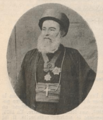Saint Thomas Christians facts for kids
The Saint Thomas Christians are a very old group of Christians living in Kerala, India. They are also known as Syrian Christians of India, Nasrani, or Nasrani Mappila. This community is made up of Malayali people who speak the Malayalam language.
They believe their faith began when Thomas the Apostle visited India in the 1st century AD. Over time, the Saint Thomas Christians have split into different churches. These include Eastern Catholic, Oriental Orthodox, Protestant, and independent groups. Each group has its own ways of worship and traditions.
Their culture is a mix of many influences. These include East Syriac, West Syriac, Hindu, Jewish, and Latin Rite traditions. They also blend in local customs and ideas from Indian and European contacts. While they speak Malayalam, they use Syriac for their prayers.
The name "Saint Thomas Christians" came about during the time of Portuguese rule. It shows their deep respect for Saint Thomas the Apostle. Locally, they are often called Nasrani or Nasrani Mappila. "Nasrani" means Christian. "Mappila" is a special title given to people from non-Indian faiths. This included Muslims and Jews who came from the Middle East and married local people. The government calls them "Syrian Christians." This name came from the Dutch. It helps tell them apart from other Christians who follow different traditions. The word "Syrian" refers to their historical and religious ties to the Church of the East, not their ethnic background.
Contents
The Story of Saint Thomas in India
According to their traditions, Saint Thomas the Apostle arrived in a place called Muziris. This was on the coast of Kerala in AD 52. It is believed he converted many people to Christianity. He also set up seven churches, known as Ezharapallikal. Some important families who became Christians then include Pakalomattam and Sankarapuri.
Jewish people, known as Cochin Jews, were already living in Kerala in the 1st century AD. This made it possible for Saint Thomas, who spoke Aramaic, to travel there. The earliest writings about Thomas coming to India are from the early 3rd century. These are found in a book called the Acts of Thomas.
Other Roman writers from the 3rd and 4th centuries also mention Thomas's trip to India. These include Ambrose of Milan and Jerome. Eusebius of Caesarea wrote that a teacher named Pantaenus visited a Christian group in India in the 2nd century. This group used the Gospel of Matthew in Hebrew.
The Seven Churches
The story of the Christians in Kerala is told in a song called the Songs of Thomas. This song was written in 1601. It says that Thomas arrived near Maliankara. He then founded seven churches. These churches are:
- Kodungallur
- Kollam
- Niranam
- Nilackal (Chayal)
- Gokkamangalam
- Kottakkavu
- Palayoor
There was also a "half church" at Thiruvithamcode Arappally. The song also tells how Saint Thomas converted Jews and local people. He even converted the local King at Kodungallur. The Songs of Thomas also describes his work in other parts of South India. It says he was martyred, or killed for his faith, in Mylapore. This place is now in Chennai, Tamil Nadu.
Old Customs and Privileges
In the Middle Ages, some Saint Thomas Christians followed customs similar to Brahmins. For example, they wore a sacred thread. Historian Pius Malekandathil believes they adopted these customs. They also gained special rights during a time when Brahmins were very powerful in Kerala.
He suggests that in the 9th century, Syrian Christians in Kerala joined with Persian Christian traders. They became a strong trading community. Local rulers gave them special rights. This was to help bring in money. It also helped to challenge Buddhist and Jain traders. These groups were competing with the Brahmins for power in Kerala at that time.
Images for kids
-
Kozhukkatta is a food made by Nasranis on the Saturday before Palm Sunday. This day is called Kozhukatta Saturday.
See also
 In Spanish: Cristianos de Santo Tomás para niños
In Spanish: Cristianos de Santo Tomás para niños












